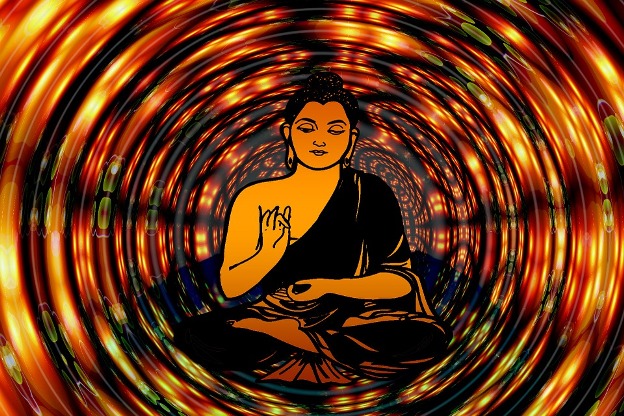As mindfulness has become a buzzword, more meditation teachers are showing up in magazines, offices, schools, non-profits and fitness studios from all walks of life, with all kinds of backgrounds and levels of talent and training.
Last week I posted an article called “Is Teaching Meditation The New Bartending.” It called for teachers having some credentials to ensure the integrity of their practices. The feedback I got was incredible.
Spiritual trends have moved in and out of dominant cultures all over the world, throughout history. At the Buddha’s time there were tons of other yogic teachers, but it was his teachings that would go on to last 2,600 years. How can you know if you should really be teaching meditation?
1) You practice what you teach.
This is the most important requirement on this list. One of my pet peeves is being in a yoga class where something about the sequence is intensely unpleasant and I know: this person didn’t care enough about my body to do this sequence first.
It’s an instantaneous breach of trust. And the opposite stands true. I can tell when a teacher spent time repeating a mantra, or did an intention practice in the morning, and it makes me feel fundamentally cared about. It also breaks the “guru” wall and makes me feel safe: they’re also a person—they just have more time practicing than me.
If you go to a therapist who doesn’t go to therapy: stop. You know you’re a meditation teacher when you find new and innovative ways to build practice into your life: listening to dharma talks on the subway, taking three mindful breaths before you get out of bed and being sure of what you’re working on at your next retreat.
2) You’ve done the research.
You know what you teach. If you teach mindfulness, you know the origin of the word. If you’re giving a talk, you’ve written out a quick brainstorm or story board clarifying what you want to say. You cite people who have more experience than you regularly. You probably even have a file on your desktop full of quotes and stories.
If you’re going to quote the Buddha, you don’t quote what your mom’s friend’s sister posted that Buddha said on Facebook, you check out “Access To Insight” and start browsing “Dharmaseed.” If you’re talking about non-violence, you go beyond the Yoga Sutras themselves. In fact, it’s one of your favorite things about teaching: that obscure Martin Luther King essay you found for a class transformed your relationship to the concept of ahimsa.
3) You see dharma everywhere.
On TV and the radio. Even when people are arguing, it reminds you that Ajahm Brahm talk about attachment to mental formations.
4) If you aren’t hearing dharma somewhere, you go somewhere to hear it.
On bad days, when you’re confused who do you call? What do you go to for refuge? Do you go to a spiritual community or call a teacher? Do you find yourself meditating even when you don’t want to or when you need to process an intense emotion?
5) You have a million ways of saying “I don’t know.”
You’re totally awesome at answering questions with questions and you avoid giving unwarranted advice. I know that you are wise and you teach meditation, but you do not know what’s happening in someone’s mind. And you don’t want to take away their power. Especially if they just heard your dharma talk and met you 25 minutes ago. You can listen, hold space or give them ways to “play” or investigate their own mind in practice, but if they ask you if they should make a major life change, the ethical answer is: I don’t know.
6) And you know when to give advice and share experience.
If someone tells me they’re struggling with substance abuse, I’ll usually tell them my history and offer them resources. I’ll never forget when I asked my yoga teacher about a problem with my hip and she said: “It’s good to know what’s going on if you can: get an MRI.” Similarly, if someone has a serious behavior or emotional imbalance that worries me, I recommend them to a mental health professional.
7) You have a referral list.
You might not even like some of the people on there, but they are experts and you love your students. You send people to therapists for mental health advice, have a crisis response team number and emails of body workers and doctors if they need physical help. You know a Vedic teacher who’s great at using yoga nidra to work with anxiety, one who is totally calm, cool and collected working with loud, entitled men and one who has a degree and extensive training working as counselor for people after sexual assault.
8) You trust yourself with power and empower your students instead of capitalizing on their insecurities.
You never sleep with students. You never exploit them for money. If they start to project that you’re too perfect a person, you might even tell them about your messy room.
9) You come prepared enough to improvise and offer modifications.
You wrote an incredible dharma talk on death and loss…and when you show up to set up for meditation, everyone is seriously stressed out. Can you guide a calming meditation? If the sounds in the room are loud and you’re leading samatha, acknowledge the circumstances and offer guidance on how to deal with distractions.
Remember: teaching is a service position. This is about your students, not your grand plan. If you can’t reroute your plans, be comfortable letting someone know that this class isn’t for them and direct them to another time or teacher.
10) You do some free service or volunteer work.
It’s the rent you pay to live on this planet. If you don’t do this, you missed the point of spiritual practice.
11) And you take care of your finances.
You get paid, you know how you’re getting paid and by who. Some Dharma teachers work on Dana, which means that the teachings are free and students choose to support the teachers work through donations. Some Dharma teachers charge fixed rates. How you choose to get paid is up to you, but before you show up to teach, it’s important that you know the deal. If a studio is cutting you a check, do you know when payroll happens? If you’re handling cash, but renting space, do you know when you need to pay rent? Modeling healthy boundaries is key to healthy student-teacher relationships.
12) Speaking of boundaries: you show up on time to teach and leave in time to get home for bed.
The necessity of self-care for teachers cannot be overstated. Again: model your boundaries for your students. Show up well fed and with enough time to take care of any last minute logistical errors that could impact your class. We’ve all rolled out of bed and rushed into a class five minutes late on a difficult morning. As a student, it happens. As a teacher, you are responsible for holding the space. You need to have your student’s backs.
13) You feel immense amounts of gratitude for your teachers.
Seriously. It’s not easy, and they have helped you, inspired you and encouraged you so much. You can’t imagine where you would be in your life if they hadn’t spent the time they did practicing and teaching and working with you when you were struggling or annoying. And you’re grateful to yourself for showing up, practicing, seeking them out and asking questions…speaking of which:
14) You thank your students.
It’s so freaking radical, that when they could be shopping, eating or drinking away discomfort, they show up again and again to cultivate a kind of peace that comes from within. You could never be where you are without them; they inspire you and teach you more than they know.
15) You aren’t perfect.
You know that there are parts of this list you’re still working on. And you’ll keep working at them because you’re committing to learning and practicing. More than anything teaching is an opportunity to grow and serve.
The Buddha said that proximity to wise teachings and teachers was such incredibly good karma and you get to be surrounded by these practices as your lifes work. May you be clear and honest, may you be free from stress and suffering, may the blessings of your life go to benefit all living beings.
Author: Sydney Faith Rose
Editor: Catherine Monkman
Photo: Pixabay









Read 0 comments and reply